Lives Derailed: On the 60th Anniversary of the Kendal Train Crash
In 1957, Norman Manley was Chief Minister, Alfred Hitchcock’s new thriller, Vertigo, had recently premiered at the Carib Cinema, and Radio Jamaica and Rediffusion filled the airwaves with programmes such as ‘Talent Parade’ and Alma Mock-Yen’s ‘Tea Time’.
It was the final weekend of summer and the parishioners of the Holy Name Society of St. Anne’s Roman Catholic Church in Kingston, led by the Rev. Father Charles Eberle, were busy making preparations for an all-day excursion to Montego Bay. The trip had been widely publicised throughout the city and hundreds had planned to make the journey.
“I was planning for it months ahead and don’t ask if a didn’t spend money! I bought new everything because I wanted to go on the trip brand new…”
(Kendal Crash Survivor, Dorrel Dobson, in an interview with The Star , September 5, 1982, p. 12)
On Sunday morning, September 1, 1957, the platform at the Kingston Railway Station was abuzz with would-be travellers eager to secure a coveted seat on the diesel-hauled train readying for departure. The trip to Montego Bay was a smooth one. Rev. Father Charles Eberle made his way through the coaches conducting mass with his excited congregants.
The return trip to Kingston, however, would never reach its destination.
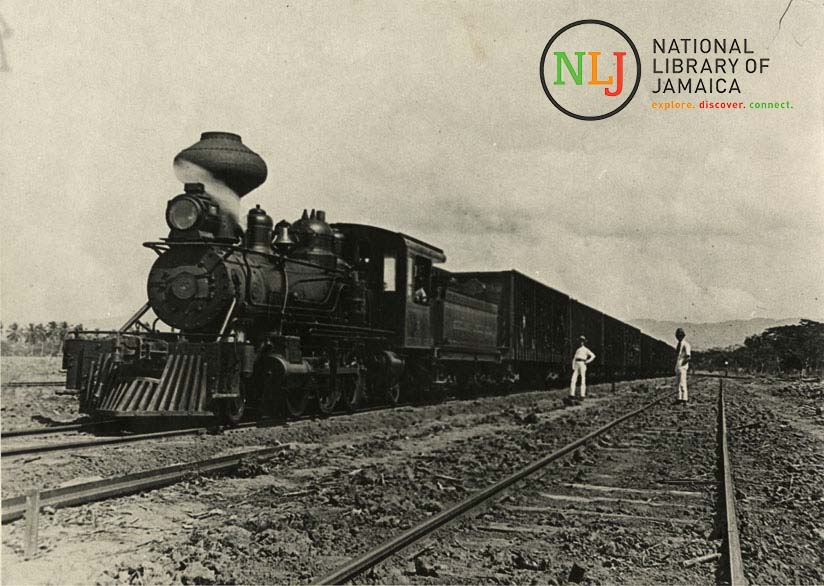
After a day of fun in the second city, weary travellers piled into the 12 wooden passenger coaches. The numbers had increased significantly. At 130-150 passengers in each coach – well over the train’s capacity of 80 persons per car – the train bore the weight of 1,600 souls.
Barrelling through the night at full-speed over rough terrain, the rattling locomotive approached a bend in the rails near the town of Kendal, Manchester. At around 11:10pm, several hundred yards from the main road to Balaclava, three train whistle blasts signalled disaster – the driver had lost control of the train.
“I then shouted to the observer Theophilus James who was beside me. ‘We dead now; we dead now.’ I prepared myself for death and made three blasts of the whistle to warn those behind that something was wrong.”
(Train conductor, Garnish Lurch, in an article for, The Daily Gleaner, Wednesday, September 3, 1957, p. 1)
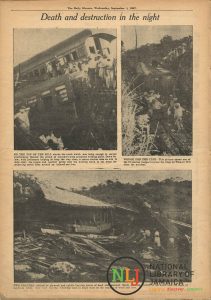
A Page from The Star, September 2, 1957
The passenger cars came loose from the engine and the derailed coaches toppled into the gully to the side of the tracks in a pile.
“Two were reduced literally to match-wood, while others were gutted or had sides torn out…One coach, with everything but the floor torn away remained on the rails and kept on running for about a quarter of a mile…”” (The Star , September 2, 1957, p.1).
The morning dawned on a grizzly scene of bodies strewn across the countryside. Some had died on impact, while many were critically injured – impaled by the twisted metal and wooden fragments. There are many heart wrenching accounts of survivors searching for their loved ones among the carnage while looters brazenly stole the possessions of the dead and dying.
“Men moved among the dead and the dying, plundering and searching for what they could get.”
(The Daily Gleaner, Wednesday, September 3, 1957, p. 1)
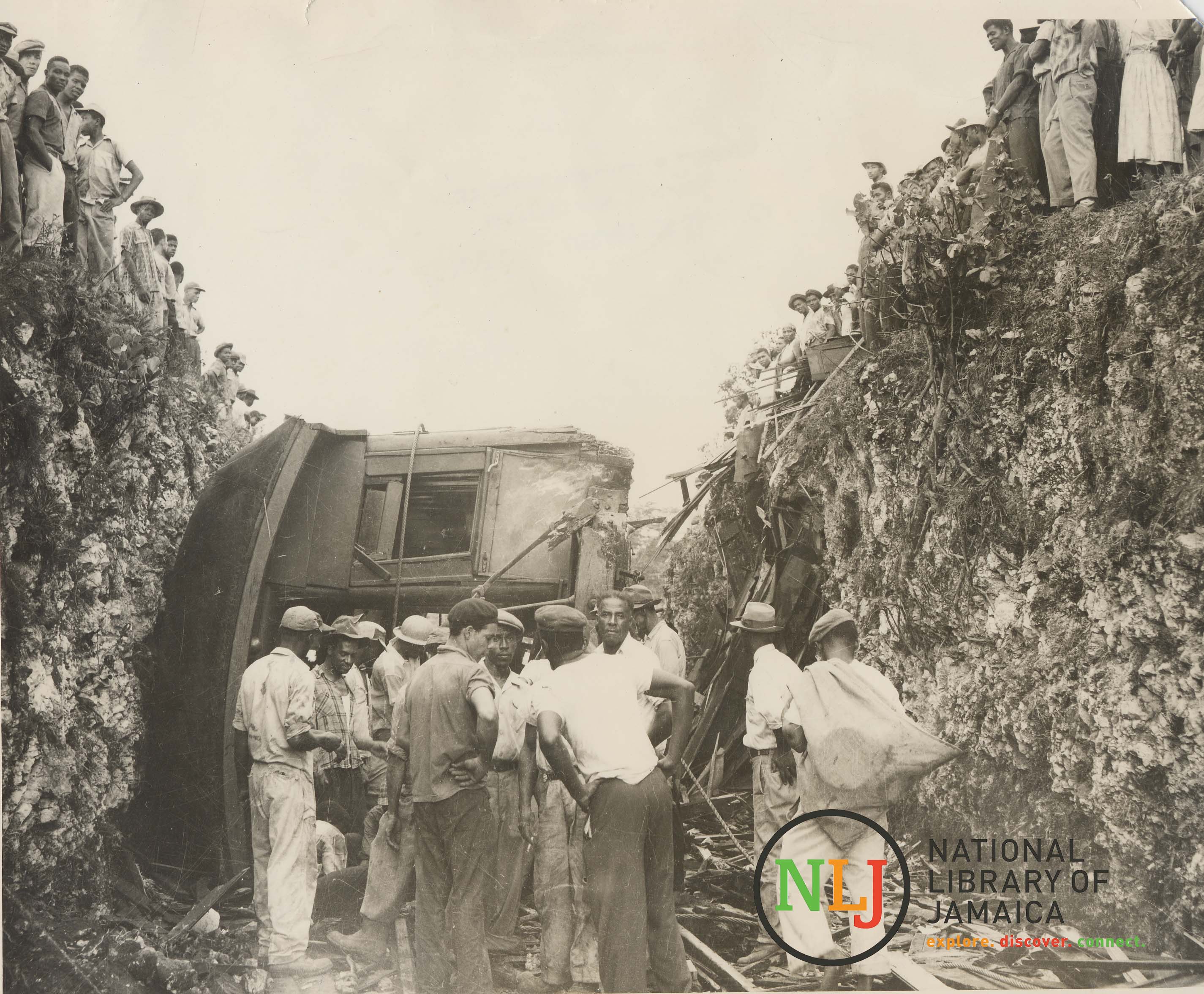
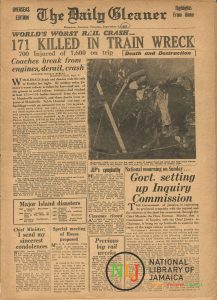
The cover of the Daily Gleaner reporting the Kendal Train Crash (September 3, 1957)
“The remaining coaches were an utter shambles, with dead and injured inside and underneath them, survivors screaming, calling for help, or crying the names of relatives or friends.”
(The Daily Gleaner, September 3, 1957)
Hospitals at Spauldings and May Pen were filled to overflowing as medical staff made appeals for volunteers and blood donations from the public.
“At Mandeville, all the bodies were laid out on a grassy knoll behind the Hospital, where lights were strung on wires from a couple of large trees to a small wooden building serving as an office and shelter. There, anxious relatives filed by all night, trying to identify someone dear to them.”
(The Daily Gleaner, Wednesday, September 3, 1957, p. 1)
‘A young woman clutched her baby, choked and fell to the ground crying, “It can’t be true. My husband, he’s not dead. Where is he?” Bystanders took her away with the child.’
(The Daily Gleaner, September 3, 1957)

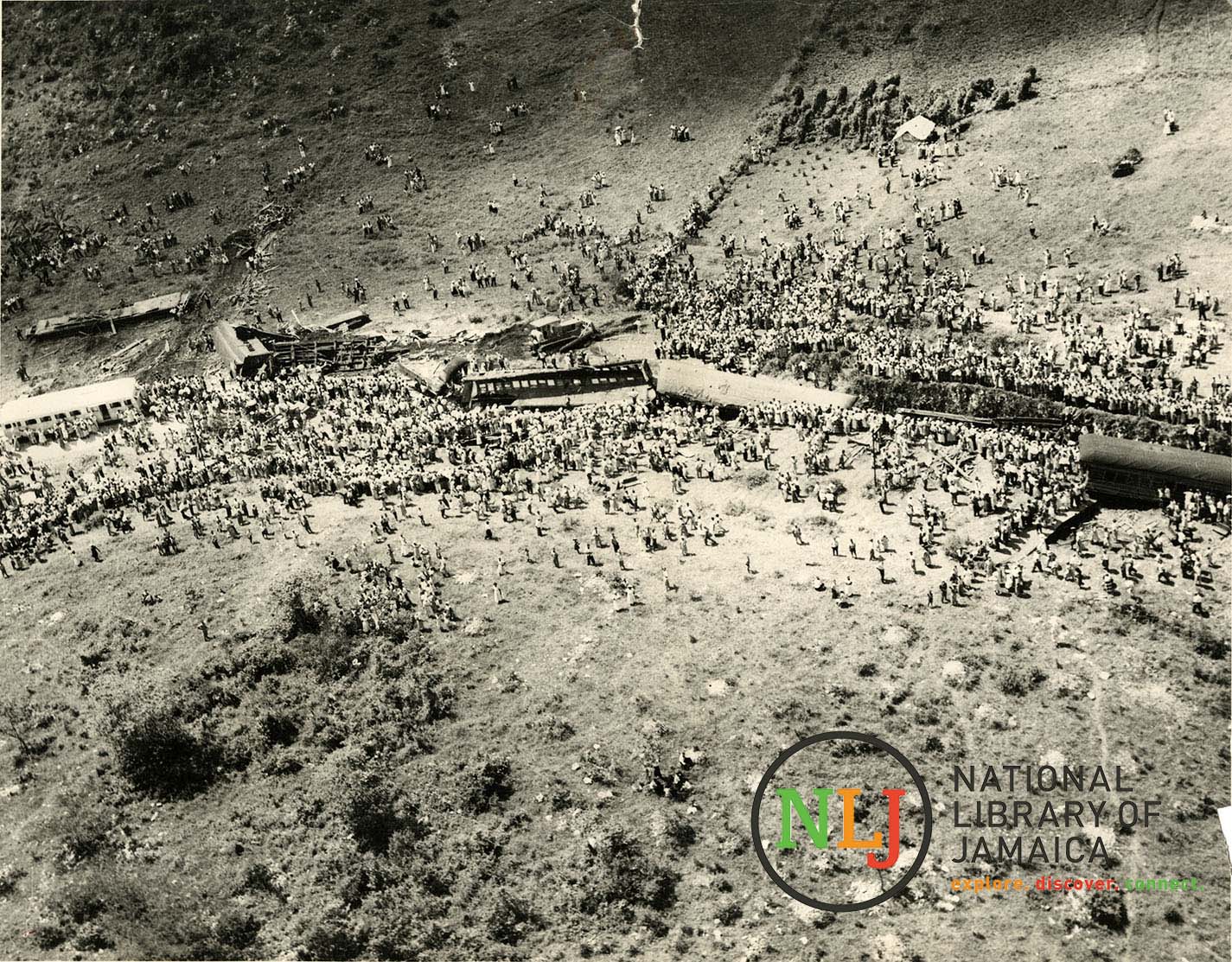
The Kendal Train Crash left 187 dead and 700 injured. Many were later buried in a mass grave near the crash site. The Friday of that week (September 8, 1957) was observed as a National Day of Mourning as world leaders sent messages of condolence and sympathy to the Jamaican people.
Through the ensuing Railway Commission of Enquiry, the cause of the crash was discovered to be the closure of an angled wheel (brake) cock. It was suggested the brakes had been tampered with. The Enquiry found many deficiencies in the Jamaica Government Railway and asserted that the trains had been kept in poor condition.
The Report submitted could not have been more blunt:
“Mr. Magnus, the Acting General Manager, has shown by his conduct in procuring a false brake certificate, that he lacks the integrity which one must expect of an officer occupying that position…”
Yet despite the findings of the Enquiry, research shows that it was the overcrowding of the coaches that played the greatest role in the extent of the carnage. Additional coaches had been added to accommodate the large numbers of passengers to whom the church had sold tickets. There were too many people aboard the train.
After the disaster at Kendal, all wooden coaches were replaced with sturdier metal ones. Still, public confidence in rail transport took a sharp decline.
The Kendal Train Crash was a national disaster that touched the lives of thousands of Jamaicans. The story of what happened at Kendal must never be forgotten.
* * *
The Ministry of Culture, Gender, Entertainment, and Sport recently announced that September 1 will be officially recognized as a day of commemoration for the Kendal Train Crash.
Don’t miss Lives Derailed: The 60th Anniversary of the Kendal Train Crash in Jamaica. The exhibition also includes information on the development of the train system in Jamaica – which remained active for 150 years. Videos, photographs, and historical documents (some never before seen) make this an exhibition you don’t want to miss.
Lives Derailed will be on display at the National Library of Jamaica until the end of October 2017.
Were you or someone you know affected in some way by the Kendal Train Crash? Share the experience with us in the comments below?

My mother told me about a friend of hers who was disappointed she did not make the Kendal trip as planned and wept when she heard of the tragedy!!!
My mother was 15 at the time. Her school was going on a trip and she wanted to go too, but her grandmother for some reason had a bad feeling and refused to let her go. She begged and pleaded and was heart broken that she didn’t get to go. Later she found out what had happened and so many of her class mates had died. Some of their bodies were never identified. I grew up hearing the story all my life and now I see the images and accounts. I have no words to express what I’m feeling……
My cousin came back the following afternoon with a mangled leg. Our church kept the outing.
Also many members of our church St. Anne’s died.
Also many members of our church St. Anne’s died.
The young girl 1st picture on the left was my cousin my mom was on that train 5 months pregnant with me I was born 4 months later January 1958
Wow!Thanks for sharing!
Wow
And jamaicans still have not learnt anything. They still overcrowd and overload passengers, drive recklessly and under maintain their vehicles. SMH
I would like to know the name of the breaks operator on the train. I think we were related
I would like to know the name of the breaks operator on the train. I think we were related. Thanks for sharing.
Very enlightening read, sad but worth it for me. PS: Don’t leave out the ensuing ghost stories associated with that incident.
Yeah I heard a lot especially from my grand mother
I remember my mother talking about this tragedy, 4 of her cousins died in that crash, their names were Reid, I think one was called Hyacinth,they were her Uncle Arthur’s children. Is there a list of the names of casualties on there, as I am researching my family.
i love these stories, please share
Thanks for this information on our little know history on this major disaster in Jamaica,I heard about it from my Parents and Grandparents but wasn’t any details, happy to know more of our almost forget history, Keep up the good work,
Remember Doris Gwendolyn Groves—Monteith? She was the nurse on the scene at the Kendal crash. She received a commendation for her heroic work
Was she a member of the East Queen Street Baptist Church? I knew a lady by that name
No,she was not a member of that church but, my uncle’s wife, Hazel Monteith of radio fame was.
Such a tragedy after such an enjoyable day. R I P
My mom was a nursing student and was at Mandeville Hospital helping. She told me about all the bodies piled up under the tree. I don’t know how she was able to do that but she was there doing what she could. Such a terrible tragedy.
Suggestion that exhibit stay until end of year that visitors to the island could see it during the holiday season.
I am from Manchester but I never knew the story. Always heard mention of “kendal crash”. Never ever imagined it was so horrific.
I just found out last year that my father was supposed to be on the train tbat day, but instead decided to go to work and gave his ticket to the person who was supposed to work for him.
my mom told me that her brother and his girlfriend was suppose to go and he missed the train but she went ahead without him and lost her life
A sad and historical day in Jamaica history.I pray that all those soul we lost are resting in peace. I was only 1 yr. Old at the time of this incident, this has been of great value of information to me.
Thanks you.
Very interesting read. I have always heard of Kendal crash but never jnew the details. May their souls RIP
My father Clarence Graham now deceased lost his right arm in the Kendal Crash.
My cousin, Norma and her boyfriend Junior Scarlett, a friend named Glenda and I, Valencia Coleman was supposed to be on the trip. We got outfits for the trip, black stove pipe pants and each with a different shirt style blouse. My aunt, Norma’s mother pleaded with us not to go. She said, your father in America would be devastated if something should happen to you under my care. Norma was stubborn and said you was going. She told me not to tell Glenda but she would sneak off and leave Glenda behind. Later we could hear the train horn blowing as it sped along the tracks and Glenda got up and said isn’t that the train we are suppose to be on? Where is Norma and I let her know she went ahead but that I heeded my aunts advise and stayed behind. Glenda was very mad and said she would not speak with her again. Next morning Glenda appeared at our house to let us know about the tragic crash and that a lot of people had died. We waited about 4 to 5 days before Norma came home in a stupor, jaded and confused as she told the story. Many of our friends perished. We were teens and many were to go off to school, college at the end of the month.
I was 7 years old. I remember clearly all the duppy stories about the crash.
My now deceased uncle always talked about the Kendal crash and how this man found a leg and swore it was his friend Mama Jas leg. It probably had a special mark.
It was a sad and terrible night and day, but for children it was a an exiting experience.
My father Egbert Spence was the Station Master at Kendal, and our home was right there. The memory remains vivid and etched in my mind to this day.
the household, and especially my father, went several days without sleep as he managed/ coordinated activities at the event. I recall stumbling upon him early the morning lying with his face swollen near a clump of shrubs. I thought he was dead. I called to the Trackmen who hurriedly came and revived him. he had fainted and fell on a nest of wasps. despite that he soldiered on gallantly. There is so much to tell.
word
I believe my grandfather, Altamont Donegal, was a colleague of your father, as he too worked the line in Manchester, and lived in Mile Gully. According to my mother he too was one of the earliest to arrive on scene, likely having heard the three whistles. I am trying to piece together my families account and would love to know if you had any memories of my grandfather.
Your father was a friend of mine. He was a joyful and happy person. However, I can say that all railway station masters, including myself, who was only a clerk back then, will always remember that day and how we all worked hard to clear up the wreckage. I rode on the train to do clerical work of crossing the trains, especially, those that were taking the bodies and some remains back to Kingston.
My brother and I were both on that train, but by the grace of God we were. saved
We lost a lot of friends that, day. Icant,help crying
when I remember. So many young kids lost their lives that day.
I lost an uncle, who was only 14 years old. I grew up in England, but have know about Kendal crash throughout my life. I could not understand why there was not a public recognition of the most tragic event in Jamaica’s history, hence my reason for playing a small role in bringing the anniversary to the attention of the Ministry. I am so please that the Hon. Olivia Grange, Minister of Culture, Gender, Entertainment and Sport has declared 1st September as a day when the nation commemorates the train crash. I am even more pleased by Mr. Dorrick Gray, Executive Director of the Jamaica National Heritage Trust (JNHT), announcement at the 60th Memorial Service at St Anne’s Church, on Sunday, 3rd September, that there will be a plague with the names of all of the deceased erected at the crash site. Anyone which information of the names of the deceased should contact him with details.
Finally, I would like to thank my friend Beverley East for her tireless efforts to bring the tragedy to the younger generation and keeping it in the public space. She lost 14 members of her family, and her book Reaper of Souls is based on her family’s experience of that tragic day and how it affected their lives, using a fictitious family.
Thank you for your tireless efforts in bringing this to light and giving dignity to those who lost their lives. My mother died in the crash and her body was never found. Me and my sisters were left motherless with no one to care for us; we ended up in Maxfield Park. I read Reaper of Souls a couple years ago – and even though fictional it brought back so many painful memories. Thank you… I love you.
This is so sad. I was born 29 years after this tragedy but my grandmother told us alot of ‘duppy stories’ regarding the lost souls of the Kendall Crash. Stories which she swear is true.
I just watched survivor stories on YouTube and although it is so long ago, my heart breaks for those that perished and the family who still hurt from this.
I’m very sad and upset that the government havent done much in regards to setting up and keeping up a decent memorial site.
This is the greatest tragedy in Jamaica’s history, and the second most tragic train crash in the world.
I think the victims deserve better.
I was 7 years old. Our mother was supposed to be on that train but thank God was not. People from our yard never came home. Remember a dog who kept howling and waiting for his owners who never came back.
i remember that crash vividly i was suppose to be on that trip but after providing everything for the trip i lost my spending money in a dice game the night before thats why am still here
Wow! This is so sad, but awfully revealing. I have always heard about this crash (having been born in the 60’s), but the images really bring the historic crash to life.
I heard about it. Maybe the reason why my mom never talked about it was that on September 8 was when she was born. She was an orphan and her father was already dead even though not on the train, and her twin born dead at birth. My grandmother told me about it and said it was a disaster.
My mother died in the Kendall crash and her body was never found. Me and my sisters were left without a home and were placed in Maxfield Park Children’s Home. We suffered emotionally for many years; to this day my siblings have not recovered from this tragic event. Thanks you so much for bringing this story to the forefront.
So sorry to hear that! My gma was on the train and her body was never found as well. What was your mother’s name?
I remembered my late dad,Dudley Gaynair telling me and my sisters about the victims of the Kendal Crash, he was admitted at the hospital due to a shoulder injury; he heard a lot of screaming, and crying!! that was such a tragic accident!
My Mother now deceased lost her younger sister at that crash. My Mother was also suppose to go but got caught up with something else. Thanks for this info
My name is Joan Johnson-Larmond, i was not on the train my mom Elaine (Biby) HoSang was she was 3 moths pregnant with my brother Bill and she survived, however I was 9 months old at the-time and my brother Michael Johnson (deceased) was 2 yrs old when the train crashed. Our dad, grandma , cousin and aunt
was perished on that day September 1. 1957.
fathers name – Vincent Johnson
grandma – Hilda Johnson
aunt – Shirley Johnson
cousin – Joy Hobson
They were members of St Anne’s Roman Catholicism Church, dad worked for the Jamaica telephone company
Hi is Eulalee a name from your families past? She was my mums Mum, My mum is Muriel (Nuriel in JA) Christine Sinclair? Eulalee (born 1900 in Golden Grove) was Grandmother her siblings were Ezekiel Mathias Johnson born 1904, Ezekiel Elias Johson 1905, twins Esau Neremiah Johnson and Ruth Rebecca Johnson born 1908
Alfred Augustus Johnson was my Grandmothers Dad born St Thomas 1884 and his Mum and Dad were Emily and Mathias Johnson
We live in England
I am a young man, born in 1994. My home is currently near Jones Town where the long standing St. Anne’s Roman Catholic Church is still planted. I only first heard about “Kendal Crash” by an old-blind friend about 10yrs ago, whom I’ve never been weary to listen and learn from, while sitting by his side during visits at the Golden Age Home in TrenchTown, Kingston.
I later stumbled upon this red reading book, “The Blue Mahoe Series” written by Jean Goulbourne and Eileen Marshall in my high school library over a decade ago.
It has many factual old-time Jamaican stories, including “Kendal 1957”, and I fell in love with the book because it presented the events of September 01 & 02, 1957 so clearly, in the form of a News Report. Though every line seemed very clear to me and imaginary, and though I didn’t lose any close loved ones into the terrible disaster at Kendal, my heart sank deep because I could still relate to the broken-hearts of our fellow Jamaicans who had had so many family members been taken away from them so suddenly.
I would appreciate if the Minister of Culture could zone in more on this “National Day of Mourning” and commemorate the events by reflecting back at what really took place in September 1957, casting over Local Television Channels (TVJ & CVM-TV).
My uncle, Father Harry Mallete, was on the train too. He recalled giving many their last rites. When asked about how it. Affected him he He said,”God puts you where you are needed
most”.
I’d heard stories growing up I was born 3 yrs later My granny told me a lot of Duppy stories Also that they wanted blood so the crash was deliberate
My brother Edgar Hibbert and his late stepmother, Miss Rose Thompson were passengers on the fateful train wreck. He attended St. Anne’s school and was 9 years old at the time. Thankfully, both he and Miss Thompson received only minor physical injuries, but who knows about the mental impact ? Has anyone studied the mental scars of the survivors?
My father’s cousin and best friend Alphonso Davidson age 15 years died in the crash. My father most likely would have been with him, but fate had it he was in hospital with an injury.
My father’s cousin and best friend Alphonso Davidson age 15 years died in the crash. My father most likely would have been with him, but fate had it he was in hospital with an injury.
My dad told me about this kendal story , he said one of the reasons why the train crash , thieves were on the train turning off the lights and robbing people of their monies and jewelries , lots of bad things were happening on the train, he also told me there was a couch were only nons were in that couch and the thieves didn’t go in that couch and that was one of the couch that was safe, no one got hurt, he showed me a man with one leg in Papine Square
St Andrew, he told me that the man was the driver of the train. when the train crash the hot oil from the engine burned one of his leg badly . He even told me about the taxi driver and the duppy lady he picked up and take her home waiting for her to go inside for the money for the charter , while waiting the mother of the deceased went outside , the driver asked the mother if she sees a young lady went inside the mother said no , the driver started to describe the lady , the mother turned to the driver and let him know that her daughter was dead in the Kendal crash then he realized he was having a good conversation with a duppy lady while taking her home.
My mom survived this crash when she was just 13 years old. She still had the scar on her right arm from it.
Your blog is a source of inspiration.